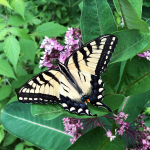Gardens
Three Rules for Transplanting Perennials
Harry Harper grew perennials from the 1940s until 1965 in a windy spot in Eden, New York, where the climate can be tough on new transplants. His rules for transplanting perennials—shared by his granddaughter, garden writer Sally Cunningham, of East Aurora, New York—These three rules for transplanting perennials can help you grow a beautiful garden […]

Coffee By Design | Portland, Maine
Photo Credit : Katherine Keenan Harry Harper grew perennials from the 1940s until 1965 in a windy spot in Eden, New York, where the climate can be tough on new transplants. His rules for transplanting perennials—shared by his granddaughter, garden writer Sally Cunningham, of East Aurora, New York—These three rules for transplanting perennials can help you grow a beautiful garden no matter where you live. Here are Grandpa Harper’s transplanting rules.
1. Avoid transplanting in the heat of the day, and never expose the roots of transplants to the sun or wind. Transplants tend to lose moisture faster than the roots can replace it, because the roots don’t function optimally immediately after transplanting.
2. Put transplants in a little “bathtub.” Set transplants just a little lower than the soil surface, in a basinlike depression, making a rim of soil to hold in extra water. Do this on a permanent basis for those perennials and shrubs that require
moist soil.
3. Use a shovel to check soil moisture near new transplants. Never judge soil moisture by the appearance of the soil surface. If the soil is dry at a depth of 2 or 3 inches next to a recent transplant, the plants need water, even if the soil surface
appears moist.
“People love to credit some gardeners with a magical green thumb,” Sally says, “but I don’t believe in it. That’s what everybody attributed to my grandpa Harper. But there was no magical gift at all. He knew what he was doing and why, and he taught me to think about things from the plant’s point of view, and to notice their needs.”
Harry Harper grew perennials from the 1940s until 1965 in a windy spot in Eden, New York, where the climate can be tough on new transplants. His rules for transplanting perennials—shared by his granddaughter, garden writer Sally Cunningham, of East Aurora, New York—These three rules for transplanting perennials can help you grow a beautiful garden no matter where you live. Here are Grandpa Harper’s transplanting rules.
1. Avoid transplanting in the heat of the day, and never expose the roots of transplants to the sun or wind. Transplants tend to lose moisture faster than the roots can replace it, because the roots don’t function optimally immediately after transplanting.
2. Put transplants in a little “bathtub.” Set transplants just a little lower than the soil surface, in a basinlike depression, making a rim of soil to hold in extra water. Do this on a permanent basis for those perennials and shrubs that require
moist soil.
3. Use a shovel to check soil moisture near new transplants. Never judge soil moisture by the appearance of the soil surface. If the soil is dry at a depth of 2 or 3 inches next to a recent transplant, the plants need water, even if the soil surface
appears moist.
“People love to credit some gardeners with a magical green thumb,” Sally says, “but I don’t believe in it. That’s what everybody attributed to my grandpa Harper. But there was no magical gift at all. He knew what he was doing and why, and he taught me to think about things from the plant’s point of view, and to notice their needs.”
Excerpt from 1,001 Old-Time Household Hints—brought to you by Skyhorse Publishing







